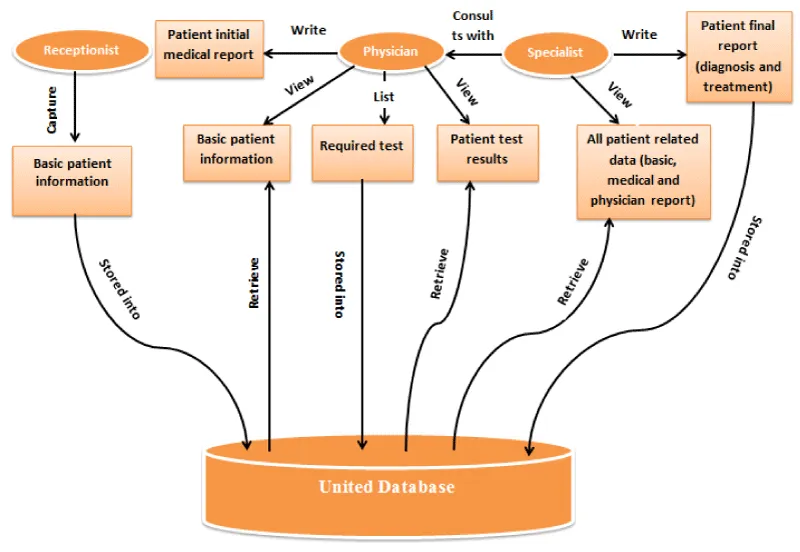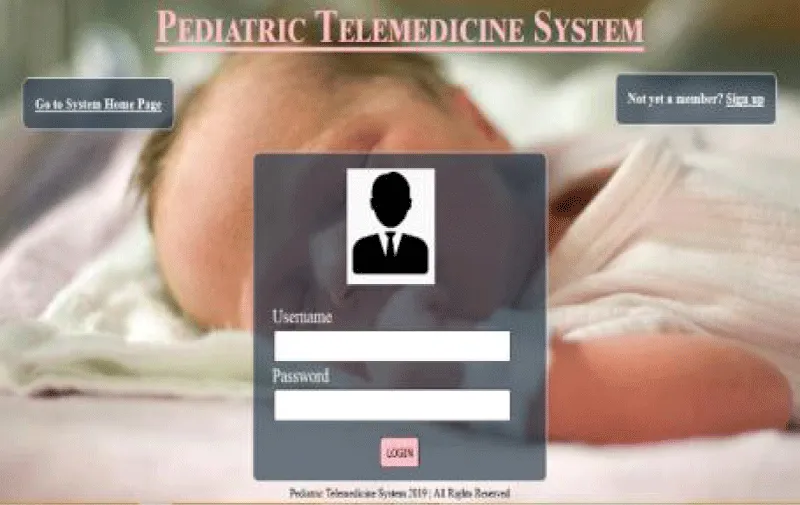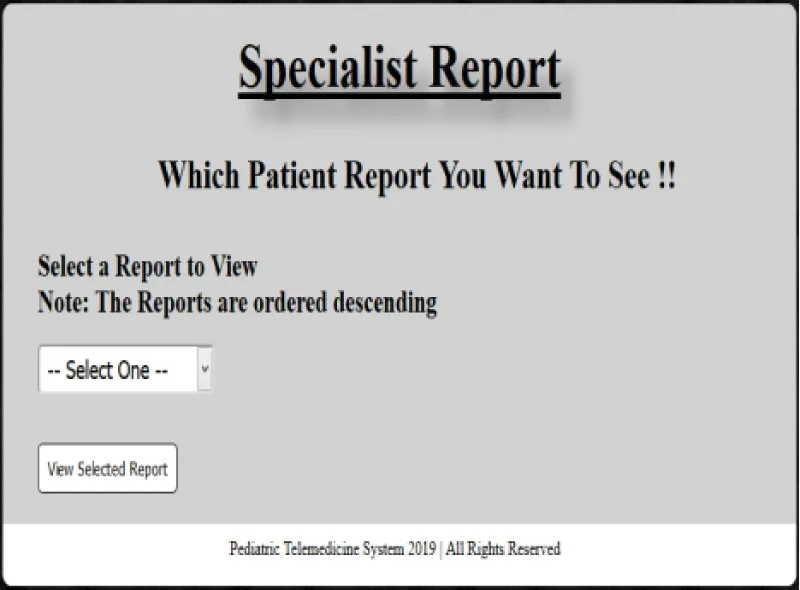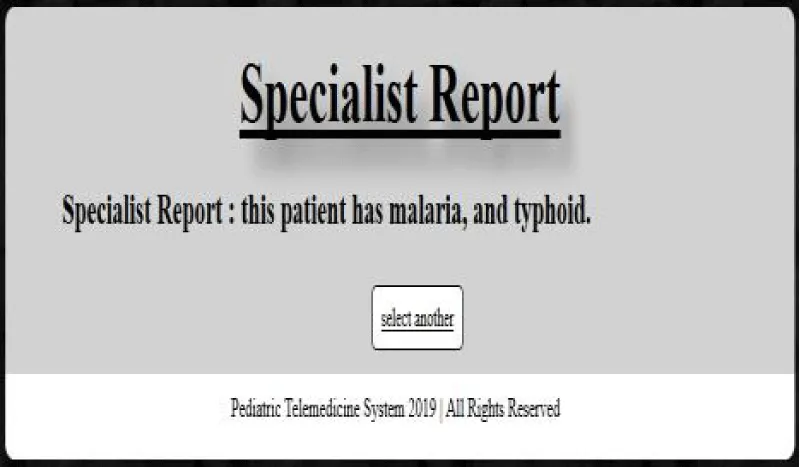Open Journal of Pediatrics and Child Health
Designing a Tele-pediatric System based on the internet
Nourelhuda Mohamed* and Mohammed Yaqoob Ismail
Cite this as
Mohamed N, Ismail MY (2022) Designing a Tele-pediatric System based on the internet. Open J Pediatr Child Health 7(1): 009-018. DOI: 10.17352/ojpch.000040Copyright
© 2022 Mohamed N, et al. This is an open-access article distributed under the terms of the Creative Commons Attribution License, which permits unrestricted use, distribution, and reproduction in any medium, provided the original author and source are credited.The outgrowth and quick development in telecommunication technologies have opened new opportunities for diagnosing many diseases, which are life-threatening, for patients who are in rural areas and districts far away from the city, and where there are no specialists. Critical and life-threatening diseases, in which the patient cannot wait until going to a central hospital, or specialist, need to benefit from the advantages of telecommunication technologies to save the patient’s life. The segment of pediatric patients represents a significant number of patients and children represent the country’s present and bright future, so we must focus on the importance of diagnosing and treating their diseases early and on a time using the ways and means available to protect their lives from risks. Designing a tele-pediatric system for monitoring such cases can be vital and efficient in saving those babies’ lives and protecting them from significant risks of disability and even death that happen if their defects are not diagnosed and treated soon after birth. This project aimed to design a tele-pediatric system, using webpages at both transmitting and receiving sites and connected to a united database and then linked with the Sudan University of Science and Technology’s Network for testing its efficiency and effectiveness. If this project is applied; it will contribute to saving the baby’s life and raise the overall health care.
Introduction
Telemedicine can be defined as “medical care and health-supporting practices based on patient information derived from images transmitted from a remote site.” This definition states the condition for handling telemedicine as a branch of medicine. Telemedicine has already been used to transmit standard x-ray, Computerized Tomography (CT), and Magnetic Resonance Imaging (MRI) images. Also, Electro-Cardio-Gram (ECG) signal has been transmitted. There are a lot of conducted projects in which imaging and its interpretation are central to the diagnosis or management of the patient [1].
Tele-consultation is a consultation at a distance. It is an applied method used in different fields of medicine for interaction between a remote area’s patient, a doctor, and a central specialist who assists in diagnosing and treating the patient. Tele-consultation is done over different communication technologies like the Internet, Wide Local Area Network (WLAN), Integrated Services Digital Network (ISDN), and other different communication means [2,3].
Pediatrics are exposed to a variety of dangers, such as interruptions during pregnancy, genetic anomalies, perinatal injuries, congenital defects, malnutrition, environmental diseases, infections, poverty, traumas, violence, and exploitation [4]. Pediatrics who suffer from vital and life-threatening diseases, such as lung diseases and congenital heart diseases - which require continuous monitoring - face difficulty in obtaining the required treatment and medication because of the small number of specialist doctors (pediatricians) compared to the number of patients [5]. This disease may lead to permanent disability or even death if not well diagnosed and treated effectively as soon as possible. Designing a web-based tele-pediatric system to diagnose such diseases will help save those children’s life as a united database system will enable storing and retrieving all pediatrics-related information, so better diagnosis and treatment plans can be achieved, and a tele-pediatric system based on the internet can help easy interface between the user and the designed system and ensure the capability of having a consultation between a distant specialist and a physician located where the patient is through the internet can help the health care services for rural and remote areas patients.
To design such a system, a database; which is a collection of related data, must be created to convey the whole information about the patient, such as basic information like name, gender, address, previous diseases, and medications, to which insurance company they belong, the required medical tests needed and their results to diagnose the patient case and assign the appropriate treatment plan, the basic information about doctors involved in the telemedicine system, information about the remote and referral hospitals involved in the system and much other information [6].
In order to create a such database; that stores data in such a way that it becomes easier to retrieve, manipulate, and produce information; a lot of tools are available [6].
Literature review
All of the developing countries suffer from the lack of government commitment toward healthcare services and programs, limitations of communication technologies use and application, and funding issues [7]. Therefore, a lot of telemedicine and tele-pediatric projects were conducted all over the world. There was a project which was conducted in the Sub-Himalayan state of India. This state was a Mountainous area so populations cannot access basic and advanced health care services due to geographical barriers. So, a collaboration project between Telemedicine Resource Center, Sanjay Gandhi Postgraduate Institute of Medical Sciences (SGPGIMS), Lucknow, India with funding support from the Government of Uttaranchal to link the PHCs, CHCs and district hospitals of the state, Integrated Services Digital Network (ISDN) was selected as the desired network, and project manpower appointed were three telemedicine technicians one Network Engineer and one Project Assistant, after the establishment of the system, it was tested and all the hospital staff was trained on it [8].
Also, there was a tele-pediatric system conducted in Ireland, which was a pediatric Telecardiology system. Videoconferencing equipment at both transmitting and receiving sites, PCs, cardiology equipment, network (ISDN) and personnel are the needs to conduct the project. US image was picked and transmitted over ISDN for diagnosing and saving the neonate [9].
Also, another project was conducted in Bogota´, Colombia, to reduce the number of unnecessary patient transfers. The system involves 9 primary care hospitals in Bogota´. The medical processes are modeled using the HL7+RIM. The server used is PostgreSQL and the system is developed in Java. A group of Engineers trains nineteen pediatricians to guarantee the system permanently. Then the rate of patient transfers after applying the system was compared with the previous records of the National Department of Colombia and it was lower [10].
The previous systems had been developed to best suit their respective areas, unfortunately, it is hard to apply them in Sudan, which is our case study. Sudan has a diverse geography, some areas are mountains while others are deserts, so this diversity needs to be taken into account. As the infrastructure of the internet services is better in Sudan, this enables us to better use it. Also, the cost of those systems needs to be considered, which is very high. Our target is to design a low-cost system that can help alleviate the telemedicine services in Sudan. Also, some of the aforementioned conducted systems are portable, our goal is to design a stable system in which we can collect all of the patient information which can be used in the future for achieving the unique patient medical record.
In Sudan, as a case study, there is no established database system for the country as a whole, which means that we cannot find all of the medical-related data about the specific patient in the same place. There is only one telemedicine project conducted and published, the Gezira Family Medicine Project (GFMP) that is because of the lack of government commitment towards the healthcare services in Sudan. The project is a collaboration project between the federal ministry of telecommunication and information technology and the federal ministry of health the other partners. Other important partners include the state ministries of health, the national medical specialization board, universities, and training centers in addition to the health insurance fund. The project needs a mobile car clinic and internet to be completed [11]. This system, actually, meets some of the aims of our study regarding the design of a telemedicine system in Sudan, but it lacks the design of a united database, and unfortunately, this project is no longer working, it had been stopped, because of funding issues.
Methodology
In order to achieve the goals and objectives of this research, clear steps were followed. First, appropriate database tables were created using MySQL database with XAMPP open-source webserver to convey the various types of data about patients, hospitals, receptionists, physicians and specialists. Data about patients included: basic patient information (name, age, gender, etc.), medical data (previous diseases and medications and their insurance company, signs and symptoms and required laboratory and radiology tests and their results). Hospital information included: the hospital’s name, where it is, and its phone. Receptionist, physician, and specialist data included basic information about them like name, age, address, the hospital they belong to, etc. Then, seven web pages were designed to enter the various types of data about patients (basic information, their signs and symptoms, their required tests, and their relevant results), various data about physicians and specialists, and other web pages to show the patient-related information were designed. Then, special webpages were designed to enable the physician to view the full patient information, entered by the receptionist, and write their report, thus enabling them to send all of this information along with their report and their name and phone number to the specialist to enable consultation to take place between them. To notify the specialist that a new patient is waiting for the consultation, a webpage was designed to enable the physician to send an email message to the specialist. These webpages were designed using HTML and CSS. Then, a PHP code has been written to connect these webpages with the database to allow inserting the data into the database and also retrieving the necessary data from it. Then, test data were used to test the system’s credibility and efficiency.
The suggested media selected for the tele-pediatric system was the implementation of the internet, but because it is very costly, a system was tested using two computers, one as a host server or hub, and the other as a peripheral that shares the information with the hub computer, this was done using Sudan University of Science and Technology’s network as a bridge, using the IP of the hosting computer on another computer when both of them were connected to the internet.
Figure 1 below shows a flow chart that describes the system-building process. It starts with the database design using XAMPP and MySQL, then designing the webpages using HTML and CSS, then connecting the webpages with the database using PHP, then using test data to examine the system working mechanism in the computer network, then finally, testing the system between two computers.
The first step (designing the database) was accomplished through the block diagram figured below (Figure 2), which shows that SQL programming language was used to make the structure of tables in the database, and then with the help of MySQL software application, the database was created. The XAMPP was the server used.
Then, HTML language was used to build the code of structure of the webpages and CSS language was used to make the styling applied on the webpages [12-14]. Both HTML and CSS codes were written in notepad++ editor, to enable us to launch webpages with an internet browser. Also, PHP codes were written on the notepad++ editor. These codes were written to connect the webpages with the database, that is; data entered through the webpages are directly stored in the database. Then, some testing data were used to examine the proper working of the webpages with the database, that is; entering data through webpages and see whether it was stored in the database or not and if data can be retrieved from the database. Finally, the overall system was tested using Sudan University of Science and Technology (SUST)’s network, two computers were used, one as a central computer, and the other as a peripheral. Both computers are connected to the network; and using the IP address of the central computer, the peripheral computer accessed the Tele-pediatric system data.
After designing the system, the proposed working mechanism is as follows
- Transmitting site: After creating a webpage for patient admission, the basic patient information is acquired and inserted into the database. Then and through the physician webpage, the physician could be able to see the patient information, ask for the required tests, see the results of the tests and then write their report accordingly. And finally, the overall information along with the physician’s report, name, and phone number could be sent to the database and a notification email message is to be sent to the specialist alerting them that a new patient is on the waiting list for consultation (Figure 3).
- Receiving site: After the data from the sending site was stored in the database, a special webpage was created for the specialist enabling them to see the basic patient information, their required tests and their results, and the preliminary physician report about the patient case. If the sent data are not enough, a consultation can take place between the physician and the specialist. Then the final report about the diagnosis and treatment of the patient case is written and sent back to the physician. A treatment plan can also be reported and sent back with the report. The transmission and receiving media is the internet using TCP/IP protocol (Figure 4).
Thus the overall working mechanism of the system will be like the illustration in Figure 5 below. The united database was created. Then the receptionist through his webpage can capture all patient basic information and store it in the database. The physician then can retrieve this basic data from the database using his webpage, ask for the required tests, see the results of the tests and write their initial patient’s report and send all of this data to the database. The specialist then can retrieve all of the patient-related information from the database using their website, look at it and write their final patient report (diagnosis and treatment plan). If the patient situation needs consultation, a conversation between the physician and the specialist can take place as the physician’s phone number exists in the database.
Results
Following the methodology of the system design discussed earlier, and by manually adding sample data to the database to test the system, the following web pages were designed.
A. System webpage
This webpage represents basic information about the system (Figure 6). It contains the project’s name and an icon that lets the visitor see the Arabic version of the system. Then there is the main menu which includes:
- Home icon: when clicking on this icon, it directs us to general information about telemedicine, how to make the connection between the transmitting and receiving sites, the different types of telemedicine where it is real-time, or store and forward, and how to make consultation between the two sites of the connection.
- User’s icon: this icon is a dropdown list that represents the different types of system users (Receptionist, Physician, or specialist). By clicking on any of the list items it redirects the user to the user registration webpage in order to enter their basic information to be a valid system user.
- About us icon: this icon redirects the system visitor to a clear definition of the system designers, the reasons why this system was created, and what services this system can provide.
- Contact icon: this icon redirects the visitor to the SUSTTECH webpage, which is a webpage related to the Sudan University of Science and Technology as a reference for this system.
- Help icon: by clicking this icon, the visitor can know what the server and technical problems that they can face, are and how they can fix them by themselves or contacts the system designer for help.
B. User registration webpage
This webpage was designed to enable the user to enter their basic information and make an account in order to be an authorized user (Figure 7).
From this webpage, the user can go back to the system webpage by clicking the link in the upper left corner. If the user is a new member, they must register their information first, otherwise, they can just sign in by clicking the link located in the upper right corner. This link redirects the user to the login webpage which will be discussed later.
This webpage allows the user to enter their career (receptionist, physician, or specialist), name, age, address, valid phone number, and the ID of the hospital they belong to, then they must have a username and a password that they can remember. By pressing the login button these entered data are directly stored in the database in the user table, and at the same time, and according to the specified career, the user is redirected to the appropriate webpage. The receptionist will be directed to the patient admission webpage, the physician to the physician’s webpage, and the specialist to the specialist’s webpage. Details about this process will be discussed later. The reset button is used for resetting the input fields for correction.
C. User login webpage
This webpage allows the user who had already registered to the system before to just enter their valid username and password to go through the system. If the user is redirected to this webpage without registration, they can just click the link located in the upper right corner to go back to the user registration webpage. The user can also use the upper left corner link to go back to the system webpage (Figure 8).
D. Patient admission webpage
This webpage was designed to enable the receptionist to enter all of the patient’s relevant information. First, they can capture the patient’s photo, and then they can import it to the admission webpage by clicking the browse button, selecting the photo, and pressing the Enter key. The date and time will be automatically set to the current date and time and they need not be entered. Then, they can enter the hospital id, patient’s name, age, gender, address, phone, religion, previous diseases and medication, and the insurance company that the patient belongs to. If the receptionist needs to correct most of the data they enter, they can just click the reset button. By clicking the send button and after filling all of the fields, the patient data will be sent to the database and stored there for future use. On the top left side of the webpage, there is a waiting list designed to represent which patient is next to meet the doctor (Figure 9).
E. Physician webpage
This webpage (Figure 10) enables the physician to look at the basic patient information entered from the admission section just by clicking the patient information link located at the top left corner of the webpage. The webpage in Figure 11 will appear. The physician needs to select the name of the upcoming patient to know their full information (Figure 12). These names are ordered in descending, that is, the last patient entered will be the first one to appear. The physician ID, as well as the Patient ID, are required fields on this page to have full information (specific physician stated specific testes to a specific patient).
After seeing the basic patient information, and determining which tests are required, the physician can see the test results by clicking the link at the bottom of the page (see result/report), then from the same link, they can see the specialist report (Figure 13).
This second physician’s webpage allows them to look at patients’ results by clicking the see a result link in the top left corner of the webpage. By clicking this link, the physician will be redirected to the patient’s results webpage (Figure 14). The physician needs to select which patient’s test results they want to see by determining a specific patient ID and clicking the view selected results button.
After looking at the test results of the patient (Figure 15), the physician needs to write their own report about the patient’s status. By clicking the send button, all the data will be stored in the database. Then an email message containing the ID of the patient who we need to consult about their status is sent to the specialist.
F. Sending email message webpage
This webpage was designed to send an email to a specialist when all of the patient’s related data (basic information, medical history, requested tests and their results, and the physician’s report) are ready to send. And the physician at the sending site is ready to make a consultation with the specialist about the patient’s status. This form (Figure 16) is filled out by the physician and sent to the physician.
All of the above web pages are considered the transmitting site of the system.
G. Specialist webpage
If the user login to the system as a specialist, then they will be redirected to this webpage (Figure 17). This webpage is considered the receiving side of the system. First, the specialist can look at the full information about the patient by clicking the link in the upper left corner. The below figure shows the webpage that will appear after clicking (Figure 18).
Then the specialist needs to select a specific patient ID to view the patient documents. This ID is in the message that the receptionist receives. The example of the selected documents appearing to a specialist was in Figure 19 below.
Depending on the information sent from the physician, a consultation between the physician and the specialist can take place. When the physician writes their reports, at the end of the webpage they must write their name and phone number to enable contact to occur.
Finally, the specialist can write their report about the case from the specialist webpage. And send it back to the physician. This report may be the diagnosis of the patient’s case or a helping guide for the physician to assign the correct diagnosis and treatment plan for the patient.
The physician can see the feedback report that was written by the specialist from a link in the physician webpage that appears in Figure 13. By clicking this link, the webpage in Figure 20 will appear. Selecting the ID of the patient, the physician can see the specialist report.
Figure 21 shows an example of the reports that can be sent back by the specialist to the physician to enable diagnosis and treatment of the patient’s case. Otherwise, a telephone call can happen between them.
All of the represented data in the results section is sample data entered manually into the system to prove its working efficiency, no real data has been used or recorded.
Discussion
Telehealth is a powerful tool to improve healthcare services for populations living in remote areas. Through telehealth, real-time transmission of medical data can be achieved which optimizes the communication between the local centers scattered in the territory and referral centers and reduce the repetition of exams.
This project, Designing a Tele-pediatric System based on the Internet (TSBI), was conducted to support the pediatric heath care services development in Sudan. Electronic Medical Record (EMR) system was designed to enable the receptionist to enter the patient related data, and then these data is stored in the DB.
A lot of considerations regarding the privacy and security of the patient were addressed in this project design, including unique patient ID for each patient, through whom the whole patient related data can be accessed, also the medical practitioners (physician or specialist) whom deal with the patient case can be known from the DB. These considerations guarantee the security and canonical rights for all of the different parties using the system and the patient during faults.
Unfortunately, this system has not been established yet in Sudan due to the funding requirements, however, if it is well established and applied, under the supervision of the Ministry of health, it can benefits all of the three aforementioned segments. For the patients, they can access a better health care services while they are in their hometowns, there will be no need to travel to the capital city to get the proper health services, which will save their life’s as well as their money more. For the physicians and pediatricians, they can benefit from the tele-consultation that take place while making the treatment plan for the patient as they can share experiences, and both of them will have better understanding of the case under investigation.
There is no doubt that telemedicine services can well serve all the society and bring benefits to all of the health care practitioners.
A. System cost
Establishing any telemedicine system is costly in the beginning, but comparing this cost to the system benefits, it would be cheap. Telemedicine projects have proved their efficiency and effectiveness in improving and promoting primary and advanced health care services. Web-based systems, like our system, is not costly from the perspective of database and websites design, on the other hand the hardware and networks installation may become costly. Table 1 shows this system cost. There is no doubt that this cost is high at the beginning, a common problem for any telemedicine systems, however, the cost of the hardware, software, development, and LAN network will be paid once at the system installation period and only the maintenance cost will be paid monthly as well as the employees’ wages, which may not be counted if the hospital has IT department.
B. System operation efficiency
To prove that the system is working fine, both the transmitting and receiving websites of the system were tested using Sudan University of Science and Technology network. By using one PC as hub and another PC as peripheral, the database and websites were tested. At both testing levels of the system operation, the system works efficiently and effectively. No errors or problems were faced during the system operation process. Also the privacy and security issues were well addressed and confirmed. The system were working properly while testing, however, this system has not been installed yet because it requires funding.
Conclusion
This project had designed Tele-pediatric System based on the Internet that can be used to link a remote area Primary Health Care (PHC) facility with a referral pediatric hospital using the internet. It was designed as webpages which enable the different system users to access the system. Clear steps were followed to conduct this project. First, a database was created to convey the whole information about patient (basic and medical information), and users (receptionist, physician, and specialist). Second, webpages were designed to enable users to interact with the system; also the navigation between the various system webpages is accomplished.
Finally, the webpages were linked to the database to allow both insertion and selection of the data, in order to save the different user’s rights. MySQL software application was used to create the database because of its security, as it enables user to define a specific username and password to the database. XAMPP server was chosen as a system server because of its simplicity of use and the availability of the source. HTML, CSS, and PHP are the programming languages that were implemented to design the pages and link them to the database. Notepad++ was used as a text editor for writing codes, and Mozilla Firefox was the browser used to display the webpages. Those two software application were chosen due to their simplicity and their lower RAM consumption.
Recommendations
It is recommended to add critical webpages to this system, such as a webpage for the Laboratory department, Radiology Department, Emergency and other hospital departments. Also, it is recommended to transfer this system form Tele-pediatric to telemedicine in order to serve much more number of patients. It is also recommended to make this system as a smart phone’s application, which is easier to download and use.
Institutional Review Board Statement: Not applicable; as this study was not applied on real patients. The used data was just sample data added manually to the database to test the designed system.
- World Health Organization (2021) Telemedicine Opportunities and Developments in Member States.
- Burke BL Jr, Hall RW; SECTION ON TELEHEALTH CARE. Telemedicine: Pediatric Applications. Pediatrics. 2015 Jul;136(1):e293-308. doi: 10.1542/peds.2015-1517. PMID: 26122813; PMCID: PMC5754191.
- World Health Organization (2019) Health care services in Sudan.
- Corno AF. Great challenges in pediatrics. Front Pediatr. 2013; 1: 5.
- Burke BL Jr, Hall RW; SECTION ON TELEHEALTH CARE. Telemedicine: Pediatric Applications. Pediatrics. 2015 Jul;136(1):e293-308. doi: 10.1542/peds.2015-1517. PMID: 26122813; PMCID: PMC5754191.
- Yank K. Build your own database driven website using PHP & MySQL. 2009.
- Ahmed DEE (2011) Revisiting eHealth in Sudan.
- Kapoor L, Basnet R, Chand R. Design and Implementation of Telemedicine Network in a Sub Himalayan State of India. 2006. DOI: 10.1109/HEALTH.2006.246423.
- Casey F, McCrossan B. Telemedicine in the Diagnosis and Managemnt of Congenital Heart Disease. 2011.
- Cifuentes C, Romero E, Godoy J. Design and Implementation of a Telepediatric Primary-Level and Low-Cost System to Reduce Unnecessary Patient Transfers. Telemed J E Health. 2017 Jun;23(6):521-526. doi: 10.1089/tmj.2016.0180. Epub 2016 Dec 21. PMID: 28002689.
- Mohamed KG, Hunskaar S, Abdelrahman SH, Malik EM. Telemedicine and E-Learning in a Primary Care Setting in Sudan: The Experience of the Gezira Family Medicine Project. Int J Family Med. 2015;2015:716426. doi: 10.1155/2015/716426. Epub 2015 Dec 29. PMID: 26839704; PMCID: PMC4709645.
- Meloni JC. PHP, MySQL and Apache all in one. 2008.
- W3 schools. SQL, A language for accessing databases. 2021. Available at: https://www.w3schools.com/.
- Tutorialspoint. Learn HTML and ESS. 2021. Available at: https://www.tutorialspoint.com/html/index.htm.
Article Alerts
Subscribe to our articles alerts and stay tuned.
 This work is licensed under a Creative Commons Attribution 4.0 International License.
This work is licensed under a Creative Commons Attribution 4.0 International License.






















 Save to Mendeley
Save to Mendeley
